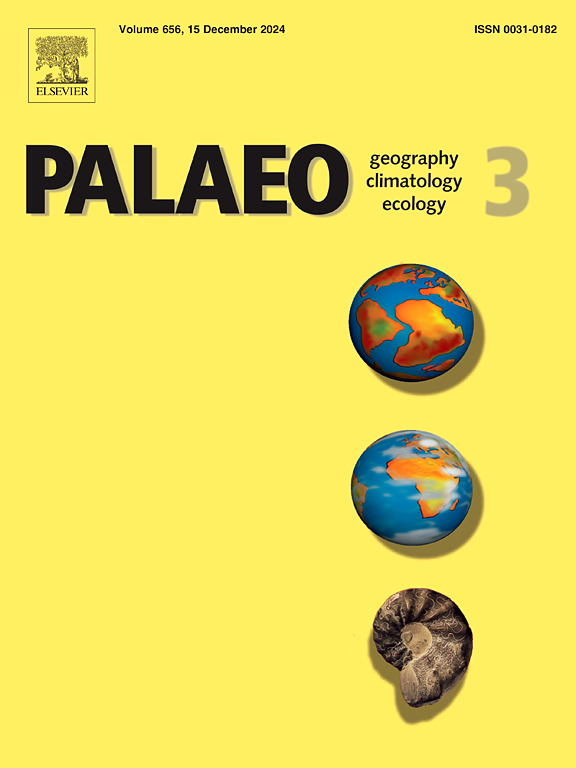Oligocene environmental changes in the Central Paratethys: Geochemical and palynofacial record from the north-western Transylvanian Basin (Romania)
IF 2.6
2区 地球科学
Q2 GEOGRAPHY, PHYSICAL
Palaeogeography, Palaeoclimatology, Palaeoecology
Pub Date : 2025-07-11
DOI:10.1016/j.palaeo.2025.113124
引用次数: 0
Abstract
The Oligocene succession exposed at Fântânele village in the north-western Transylvanian Basin (Romania), composed of the Ileanda and Vima formations, was deposited in a semi-closed Central Paratethys domain. Foraminiferal associations and lithology revealed the Late Rupelian (NP 24) and Late Rupelian-Chattian (NP 24/25) ages for these formations.
The analysed organic matter, particularly abundant in the black shales of the Ileanda Formation, is of low thermal maturity (Tmax ∼ 420 °C, Ro ∼ 0.4 %). Thus, it has not reached the hydrocarbon generation stage. The Ileanda Formation contains mainly Type II kerogen, reflecting a period of increased marine phytoplankton production driven primarily by diatoms (high C28 steranes and HBIs) and dinoflagellates (4-methyldiasterenes and dinoflagellate cysts), with bacteria playing a lesser role. The Vima Formation shows a more significant influence of terrestrial inputs, evidenced by Type II/III and III kerogen, a high share of phytoclasts, and substantial amounts of angiosperm- and conifer-derived biomarkers.
High primary bioproductivity combined with basin deepening in the Rupelian resulted in water column stratification and subsequent enhanced organic matter preservation imprinted by high TOC, hydrogen index values, and steranes/hopanes ratios in the Ileanda Formation. Low Pr/Ph ratio (mostly <1), higher contents of aryl isoprenoids, the occurrence of sulfurised highly branched isoprenoids, and a high proportion (86–96 %) of tiny pyrite framboids point to permanent anoxia/euxinia in the sea floor expanding higher, at least intermittently, into the photic zone. At the Late Rupelian/Chattian transition, the depositional setting changed to an outer shelf characterised by normal-marine conditions with oxygen-deficient bottom water. Later in the Chattian, shorter episodes of anoxia/euxinia related to freshwater incursions and subsequent salinity stratification are evidenced by pronounced input of higher plant-derived organic matter recorded in the uppermost part of the Vima Formation.
The findings highlight the role of regional tectonic activity in the Transylvanian Basin and its implications for understanding the hydrocarbon potential of similar basins in the region.
中亚特兰西瓦尼亚盆地西北部渐新世环境变化:地球化学和孢粉面记录
在罗马尼亚特兰西瓦尼亚盆地西北部的f nt nele村暴露的渐新世序列,由Ileanda组和Vima组组成,沉积在半封闭的中央Paratethys域中。有孔虫组合和岩性揭示了这些地层的晚鲁比利世(NP 24)和晚鲁比利世-夏世(NP 24/25)年龄。所分析的有机质,特别是在Ileanda组黑色页岩中,具有低热成熟度(Tmax ~ 420°C, Ro ~ 0.4%)。因此,尚未达到生烃阶段。Ileanda组主要含有II型干酪根,反映了一个主要由硅藻(高C28甾烷和hbi)和鞭毛藻(4-甲基二烯和鞭毛藻囊)驱动的海洋浮游植物产量增加的时期,细菌的作用较小。Vima组显示陆源输入的影响更为显著,II/III型和III型干酪根、高比例的植物碎屑以及大量被子植物和针叶树来源的生物标志物证明了这一点。原生生物生产力高,鲁比利期盆地加深,导致水柱分层,随后在Ileanda组中形成了高TOC、氢指数和甾烷/藿烷比值,从而增强了有机质保存。较低的Pr/Ph比(大部分为<;1)、较高的芳基类异戊二烯含量、硫化的高支化类异戊二烯的出现以及高比例(86 - 96%)的微小黄铁矿树状体表明,海底的永久缺氧/缺氧状态向更高(至少是间歇性地)扩展到光区。在晚鲁伯利—Chattian过渡时期,沉积环境转变为以正常海洋条件为特征的外陆架,底部水缺氧。在Chattian后期,较短的缺氧/缺氧期与淡水入侵和随后的盐度分层有关,在Vima组最上部记录的高等植物源有机质的显著输入证明了这一点。这些发现强调了区域构造活动在特兰西瓦尼亚盆地中的作用,以及它对了解该地区类似盆地的油气潜力的意义。
本文章由计算机程序翻译,如有差异,请以英文原文为准。
求助全文
约1分钟内获得全文
求助全文
来源期刊
CiteScore
5.90
自引率
10.00%
发文量
398
审稿时长
3.8 months
期刊介绍:
Palaeogeography, Palaeoclimatology, Palaeoecology is an international medium for the publication of high quality and multidisciplinary, original studies and comprehensive reviews in the field of palaeo-environmental geology. The journal aims at bringing together data with global implications from research in the many different disciplines involved in palaeo-environmental investigations.
By cutting across the boundaries of established sciences, it provides an interdisciplinary forum where issues of general interest can be discussed.

 求助内容:
求助内容: 应助结果提醒方式:
应助结果提醒方式:


